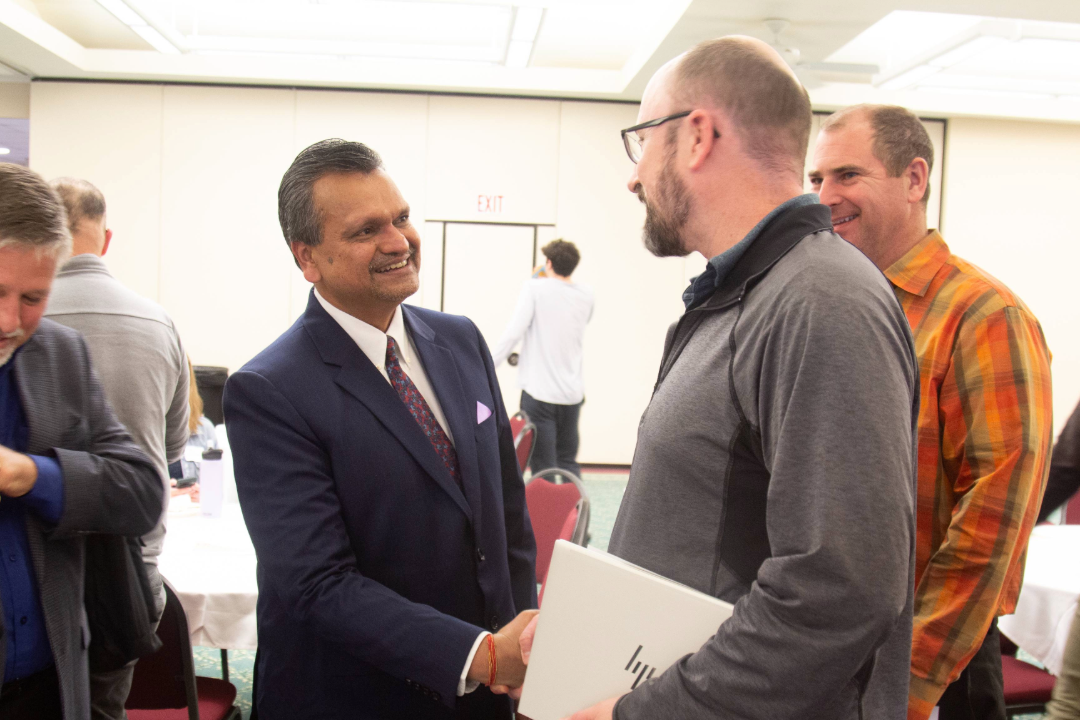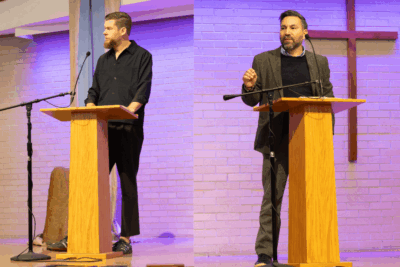For most of the semester, Goshen College has been hosting Raj Biyani ’92, an investor and mentor who worked as a managing director for Microsoft IT. On Wednesday last week, Biyani spoke on the role artificial intelligence has been playing in industry at a luncheon hosted by the business department.
Biyani said that he has spent his time in Goshen in three main areas: speaking to students, engaging with the community and presenting on artificial intelligence. Of his time here on campus, he said, “It’s been incredible. It’s been actually very, very energizing.”Jodi Beyeler, vice president for institutional advancement, said, “He’s been so generous with his time and his wisdom, and he’s a connector at heart and an energizer bunny. I’m just amazed at how much he can do.”
Biyani said, “I’ve done guest lectures in 21 classes. All the way from computer science, accounting, business, one end of the spectrum all the way to communications, psychology and religion, on the other end.”
He also has spoken at the Anabaptist Mennonite Biblical Seminary and several local churches, speaking on what he described as “Hinduism 101.”
Jason Harrison, assistant professor of business, was the organizer for the “lunch and learn” last week. He said, “I love to facilitate conversations around important topics and engage industry and education together.”
Harrison spoke on hosting such a luncheon with 100 people in attendance and the vast majority coming from off campus. He said, “It validates the role of GC again in the community and in partnership with industry.”
Biyani said, “For the one-hour talk that I gave [on Wednesday], I put in about 40 hours of research and curation time into it.” His topics at the luncheon ranged from AI’s use in Walmart’s supplier negotiations to how it will likely change the hiring process across the board.
Michelle Horning, professor of accounting, was in attendance and said, “After today, I’m wondering if we’re focused on the wrong thing.”
Though in the short term it seems most beneficial to educate students on AI use, Horning said, “In the long term, it sounds like what we should be focusing on is teaching people how to have imagination, how to be creative, how to dream, how to — what Raj said — focus on attitude versus aptitude.”
When asked if she foresaw this leading to any significant course changes, Horning said, “Absolutely.”
In his talk, Biyani used that attitude-aptitude idea to illustrate what sorts of candidates companies should be looking for. He said, “If you are only strong in the aptitude, but low on the attitude, then you may have a hard time. Because there will always be an AI agent that can do the aptitude-based tasks better than you, and the AI agent always is neutral.”
However, Biyani also described the ways in which humans are still necessary within this reality. He said that what they are seeing in the lab is that “Those communication skills, and the empathy and the high [emotional intelligence] that makes you a great manager of human beings is what will still make you a better manager of AI agents.”
Biyani repeatedly used the word “disrupt” to describe what AI is doing in the world at this place in history. Beyeler said, “We can all feel it, see it, and use it, and have some sense of the disruption already underway.”
Biyani said that AI’s power seems to be trending upward in an exponential manner rather than a linear one. Currently, it seems to be doubling each quarter, meaning that the power of AI could multiply by an estimated factor of one million in the next five years.
He said that the “power” of AI is essentially dependent on three main factors. One is compute power, which Biyani said, “The more compute power you have, the more you can process.” Another is data. Biyani said, “The more data you have, the better it’s going to learn.”
The final component is parameters. An example could be details used to describe an image. Biyani said, “[Humans] might describe five, six, eight parameters, but the AI, when it’s trying to identify looking at images, it can actually go up to hundreds, thousands, millions of parameters.”
Biyani said, “What’s happening is every quarter, each of those three dimensions is improving in capacity, and as a result, the AI is getting better, almost doubling every quarter.”
Horning spoke on how fast these changes are happening from a teaching standpoint. She said, “It probably feels similar as it did whenever the last time we had a big technological change was, where all of a sudden people who were teaching realized: ‘I’m not an expert in this. How am I going to teach my students?’”
Biyani said, “Technology is neutral, but technology amplifies intent.” One of his final points was that the key to moving forward correctly is knowing that there can be both well-intentioned and ill-intentioned people using these new technologies.
Harrison said that this was one of his key takeaways from the presentation: the opportunity to influence this enormous force of AI and the advancement of its impact on the world. He said, “We can be positive players in that space and help guide what otherwise might not be fruitful for the general population.”
At the end of the luncheon, there was a table discussion followed by a Q&A, and it was clear from the many questions asked that Biyani had given the attendees a great deal to think about.
Beyeler said, “It’s so fun to see an alum, and sort of that full circle of coming back, sharing and giving back to the community. He’s just been great.”



